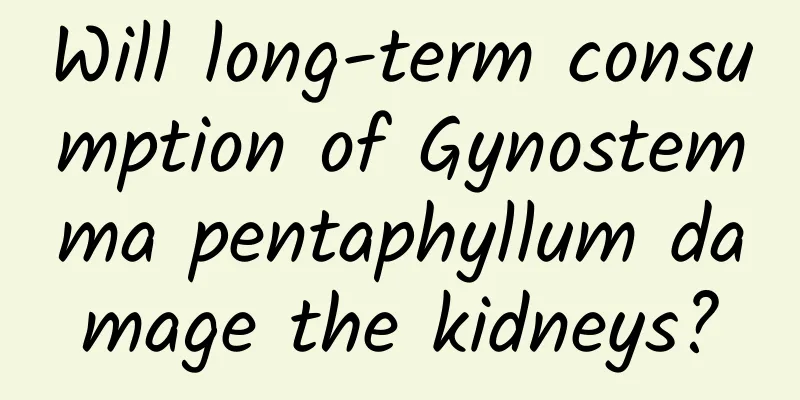Will long-term consumption of Gynostemma pentaphyllum damage the kidneys?

|
If you want to drink Gynostemma pentaphyllum for a long time, this medicine will certainly have many benefits for your body, but all medicines are poisonous. No matter what kind of medicine it is, you cannot take it for a long time. Once you take an overdose, it will damage your kidneys. It can only be used to treat high blood pressure if you take it in moderation according to your own medical condition. Moreover, this medicine is essentially a pure plant ingredient. Medicinal value This species is used as medicine, and has the effects of anti-inflammatory, detoxification, cough and expectoration. Jiaogulan is the most important, with the following Chinese medicinal properties: Boiling Gynostemma pentaphyllum and Ganoderma lucidum in water or making tea with them can treat high blood pressure, high blood lipids, high blood sugar, fatty liver and other diseases. It has the effects of protecting the liver and detoxifying, lowering blood pressure, and lowering blood lipids and blood sugar. The main active ingredients of Gynostemma pentaphyllum are gypenosides, gypenosides (polysaccharides), water-soluble amino acids, flavonoids, multiple vitamins, trace elements, minerals, etc. Medicinal material source: the whole herb of Gynostemma pentaphyllum, a plant of the Cucurbitaceae family. Nature and flavor: slightly sweet; cool in nature. Meridians: Lung, spleen, and kidney meridians. Efficacy: tonifies Qi and strengthens the spleen, resolves phlegm and relieves cough, clears away heat and detoxifies. Efficacy classification: tonic medicine; expectorant medicine; heat-clearing medicine. Indications: physical weakness; consumptive spermatorrhea; leukocytopenia; hyperlipidemia; viral hepatitis; chronic gastroenteritis; chronic tracheitis. Dosage and Administration: For oral use: decoct in water, 15-30g, grind into powder, 3-6g; or make into tea. For external use: take appropriate amount, mash and apply on the affected area. Harvesting and storage: It can be harvested 3-4 times in summer and autumn every year, washed and dried. Contraindications: A small number of patients experience nausea and vomiting, abdominal distension, diarrhea (or constipation), dizziness, blurred vision, tinnitus, etc. after taking the medicine. If the above symptoms occur, you can stop taking the medicine and rest. Economic Value Tea made from Gynostemma pentaphyllum has great benefits for the human body. Gynostemma pentaphyllum tea is extracted from the tender buds and dragon whiskers in the axils of Gynostemma pentaphyllum leaves. The tea soup is clear and can be brewed continuously for 4-6 cups without losing its color. It has health care functions brought by the nutrients contained in the growth point and can be drunk for a long time without any toxic side effects. Effects and functions: Lowers blood lipids, regulates blood pressure, prevents and treats thrombosis, prevents and treats cardiovascular diseases, regulates blood sugar, promotes sleep, slows down aging, prevents and fights cancer, improves immunity, and regulates human physiological functions. Gynostemma pentaphyllum can protect the adrenal glands, thymus and endocrine organs from atrophy with age, maintain the function of the endocrine system, and has the effects of lowering blood sugar and improving sugar metabolism. Recipe: 3 grams of Gynostemma pentaphyllum, brewed with boiling water for 10 minutes |
<<: Cooking with Creeping Grass
Recommend
Is Houttuynia cordata warm or cold?
Houttuynia root is a Chinese herbal medicine with...
Can wolfberry reduce internal heat?
Wolfberry is one of the most famous Chinese medic...
The efficacy and function of the leaves of the bellows
The leaves of the Phlox sphaerocephala are a famo...
Is liver depression and qi stagnation difficult to cure?
The liver is a relatively important organ in the ...
The efficacy and function of Fan Seven
Fan Qi is a kind of traditional Chinese medicine....
Hot, hot, hot! Why does the perceived temperature VS the meteorological temperature feel so different?
I believe many of my friends have had this experi...
The "biggest scar on Earth" is still expanding and may lead to the birth of new continents in the future
The largest fault zone In the far east of Africa,...
The efficacy and function of Tononia suffruticosa
Do you know what hairy wind vine is? If you know,...
The number of pulsars discovered by the "China Sky Eye" exceeds 1,000! | Expo Daily
Your best "insider" in the scientific c...
Can Cistanche deserticola be eaten often?
As we all know, the medicinal value of Cistanche ...
The efficacy and function of tulip root
There are many kinds of common Chinese medicinal ...
The efficacy and function of mullet
In daily life, people are not only very familiar ...
Will eating angelica kill sperm in men?
Many male friends have heard that eating angelica...
Acne broke out on my face after taking Chinese medicine
Chinese medicines are divided into traditional Ch...
Nature: Climate warming may trigger species spread and virus evolution
There are at least 10,000 viruses in nature that ...









